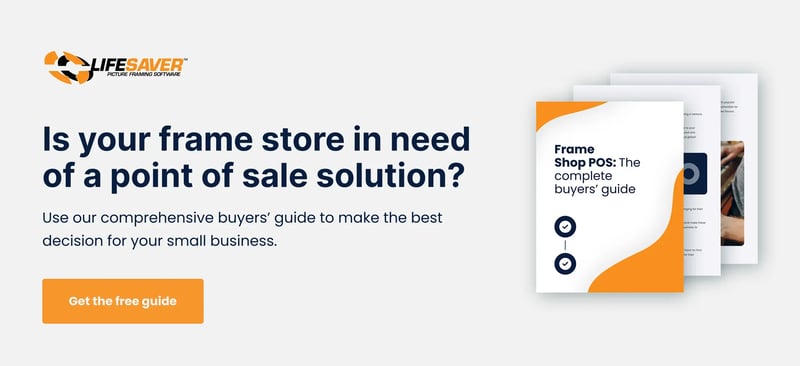
Someone walks in with a graduation portrait and says, ‘I need this framed by tomorrow.’ Do you panic — or profit? Rush orders can be a lucrative revenue stream for framing shops, but they can also slow down your entire operation if you’re not careful.
Whether a last-minute gift before the holidays or a graduation portrait needed in 48 hours, handling rush orders requires organized systems and transparent pricing.
When it comes to managing rush orders, the goal is to get the piece out the door on time without compromising quality, overloading your team, or undercharging for the change in workflow.
Want to take on rush jobs without losing your mind (or your margins)? These tips will help you stay in control, avoid common headaches, and make the most of your point of sale (POS) tools.
1. Price Rush Orders To Reflect the Real Cost
Rush framing means reconfiguring your entire production flow to meet a tight deadline. Most shops charge around a 25% premium for rush services, but it can often be as high as 50%.
To encourage high margins:
- Include overtime labor or rearranged shifts.
- Cover expedited material shipping fees.
- Factor in the risk of breakage or rework.
- Account for the impact on your regular production schedule.
Base your markup on time savings and job complexity. Use your POS software to set rush premiums based on frame type, material, or turnaround window — so you’re not guessing or calculating it on the spot.
2. Know When To Decline a Rush Job
Not every rush order is worth accepting. If you’re already booked solid, squeezing in another high-stress job could delay other work, overload your staff, and compromise quality and reputation.
Before you agree to a rush:
- Review your in-progress orders and existing delivery commitments.
- Check material availability to avoid last-minute sourcing.
- Evaluate staff availability in the timeframe required.
Setting internal criteria for rush acceptance can help your team avoid overcommitting and make managing rush orders much easier. POS software should show you real-time order volume and projected workload so you can quickly assess your capacity.
3. Anticipate the Real Costs of Workflow Disruption
Rush orders throw a wrench in even the best-laid schedules. You may need to pull a framer off a current project, rearrange priority jobs, or run a small batch of materials just for one client.
The true cost of disruption often shows up in less obvious ways, like:
- Delaying other jobs and risking missed deadlines
- Increasing overtime or weekend labor hours, adding to your staffing costs
- Diverting managers or senior staff to monitor quality closely
- Raising your error rate due to rushed decision-making
Tracking job timelines and comparing rush vs. standard order data in your POS system can help you better understand how much disruption these jobs create. That way, you can price more accurately and manage rush orders with confidence.
4. Position Rush Framing as a Premium Service
Expedited framing projects take dedicated time, priority handling, and expert coordination, which is why it’s priced as a premium service. You need to make customers see the value in your service and respect the price.
Instead of apologizing for the fee, highlight what’s included:
- Guarantee turnaround within 24–72 hours.
- Offer expert design consultations, even under time constraints.
- Provide priority white-glove handling and consistent communication.
Rather than calling it a “rush fee,” consider using language like “express turnaround” or “priority framing.” The perception change is an important psychological pricing strategy.
Create rush service tiers within your POS system to clearly show these benefits and make it easier for staff to explain and for customers to understand.
5. Adjust Your Rush Policy Based on Seasonality
Some times of year see a surge in urgent orders, while others are much slower. Treat your rush policy as something flexible, not fixed.
During high-demand rush periods:
- Prepare for holiday gift orders in November and December.
- Plan ahead for graduation and wedding orders in May and June.
- Watch for fall trends around exhibitions and seasonal décor.
Quieter seasons, like late summer or early January, are great for experimenting with new rush workflows or offering lower-fee rush options to increase order volumes.
Your POS reporting tools can help you identify seasonal trends across your previous years’ order timelines and frequencies. With this data, you can adjust when and how you offer rush framing — and at what price.
6. Keep a Rush-Ready Inventory
The faster the turnaround time, the more important it is to have materials on hand. You can’t afford to wait several days on a custom moulding when the client expects their piece by the weekend.
To stay ready for quick-turn jobs, prioritize stocking materials that are easy to access and fast to work with:
- Keep bestselling moulding profiles in popular finishes like walnut or black gloss.
- Cut mats in standard colors and common opening sizes in advance.
- Use quick-dry adhesives, hardware, and finishes that support same-day turnaround.
You can also create preapproved rush design kits: limited selections your team can offer customers with no sourcing or supply chain delays. Tagging your inventory within your POS system allows you to flag which materials are suitable for fast jobs, making them easier to find and track.
7. Build Trust With Proactive Communication
Rush clients are on a tight timeline and counting on you to deliver. Clear, timely communication lets customers know what to expect and alleviates any anxiety over delivery times.
Keep communication consistent throughout the process by taking the following steps:
- Set expectations clearly during the consultation and intake processes, including the timeline, price, and materials.
- Confirm order status changes via text or email.
- Notify customers as soon as the piece is ready for pickup.
The fewer calls or visits they need to make, the better the experience. Your POS software’s customer relationship management (CRM) feature should automatically make these updates, saving your team time and improving customer satisfaction.
Simplify the Way You’re Managing Rush Orders
Managing rush orders is easier when your tools work as fast as you do. LifeSaver gives you complete control over pricing, scheduling, inventory, and customer updates — so you can take on urgent jobs without interrupting your store’s rhythm.
Want a faster, more reliable way to take on rush work? Try a free 14-day trial of LifeSaver today.

Jul 22, 2025 4:45:00 PM








